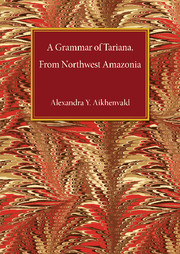Book contents
- Frontmatter
- Dedication
- Contents
- List of tables, schemes and diagrams
- Preface
- Acknowledgements
- Organisation and cross-referencing
- List of abbreviations
- Map
- 1 The language and its speakers
- 2 Phonology
- 3 Word classes
- 4 Nominal morphology and noun structure
- 5 Noun classes and classifiers
- 6 Possession
- 7 Case marking and grammatical relations
- 8 Number
- 9 Further nominal categories
- 10 Derivation and compounding
- 11 Closed word classes
- 12 Verb classes and predicate structure
- 13 Valency changing and argument rearranging mechanisms
- 14 Tense and evidentiality
- 15 Aspect, Aktionsart and degree
- 16 Mood and modality
- 17 Negation
- 18 Serial verb constructions and verb compounding
- 19 Complex predicates
- 20 Participles and nominalisations
- 21 Clause types and other syntactic issues
- 22 Subordinate clauses and clause linking
- 23 Relative clauses
- 24 Complement clauses
- 25 Discourse organisation
- 26 Issues in etymology and semantics
- Appendix. The main features of the Tariana dialects
- Texts
- Vocabulary
- References
- Index of authors, languages and subjects
22 - Subordinate clauses and clause linking
Published online by Cambridge University Press: 05 August 2013
- Frontmatter
- Dedication
- Contents
- List of tables, schemes and diagrams
- Preface
- Acknowledgements
- Organisation and cross-referencing
- List of abbreviations
- Map
- 1 The language and its speakers
- 2 Phonology
- 3 Word classes
- 4 Nominal morphology and noun structure
- 5 Noun classes and classifiers
- 6 Possession
- 7 Case marking and grammatical relations
- 8 Number
- 9 Further nominal categories
- 10 Derivation and compounding
- 11 Closed word classes
- 12 Verb classes and predicate structure
- 13 Valency changing and argument rearranging mechanisms
- 14 Tense and evidentiality
- 15 Aspect, Aktionsart and degree
- 16 Mood and modality
- 17 Negation
- 18 Serial verb constructions and verb compounding
- 19 Complex predicates
- 20 Participles and nominalisations
- 21 Clause types and other syntactic issues
- 22 Subordinate clauses and clause linking
- 23 Relative clauses
- 24 Complement clauses
- 25 Discourse organisation
- 26 Issues in etymology and semantics
- Appendix. The main features of the Tariana dialects
- Texts
- Vocabulary
- References
- Index of authors, languages and subjects
Summary
Subordinate, or non-finite, clauses in Tariana are the main device used for clause linking. Syntactically, they are adjuncts to the predicate of the main clause, expressing temporal and/or causal meanings. They fall into three groups. Subordinate clauses marked with sequencing enclitics have a number of properties that set them apart from other clause types – see §22.1. Subordinate clauses marked with the sequential enclitic -ka show some similarities to clauses discussed in §22.1. Their specific properties are outlined in §22.2. Subordinate clauses containing adpositions are a separate type discussed in §22.3. In the final section of this chapter I summarise the properties of different kinds of subordinate clauses and the principles of clause linking in Tariana. Purposive clauses, which constitute yet another type of subordinate clause, were discussed in §16.7.
Clauses marked with sequencing enclitics
Tariana has a large number of sequencing enclitics which indicate relative tense, that is, simultaneity or precedence with respect to the action or state expressed in the main clause, and to the subordinate clauses that express reason or cause. Clauses marked with sequencing enclitics behave like nominal adjuncts in that they occupy the slot of an oblique argument of the predicate of the main clause (see Chapters 21 and 25 on constituent order). They can take nominal case markers -nuku ‘topical non-subject’ and -se ‘locative’. The meaning of the locative here is slightly different from the locative used with NPs: when used with subordinate clauses, it means ‘at the time of or at the very moment after X’.
- Type
- Chapter
- Information
- A Grammar of Tariana, from Northwest Amazonia , pp. 515 - 536Publisher: Cambridge University PressPrint publication year: 2003



